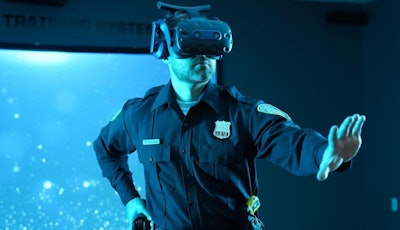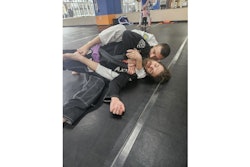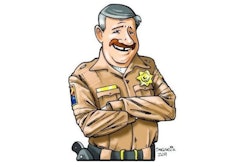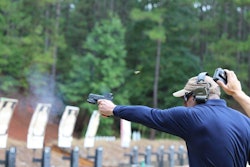 MILO VR allows officers to use a variety of replica force tools up to and including firearms.MILO
MILO VR allows officers to use a variety of replica force tools up to and including firearms.MILO
Earlier this year, Apple introduced its first virtual reality headset, the Vision Pro. Reviews from journalists, influencers, and users were mixed. But whether the Vision Pro is a hit or not, the fact that Apple is betting on the market is a sign that VR is—like artificial intelligence and other technologies that were once the stuff of science fiction—about to become a more prevalent part of our lives.
VR is also about to become more prevalent in police training, as well. At the last year’s International Association of Chiefs of Police (IACP) show several training technology companies that specialize in producing judgment simulators were showing VR solutions. One of the leading simulator makers that is adding VR training to its product line is MILO.
Robert McCue, executive director of MILO, expects the company’s VR training solution will be released in the second quarter of this year. Right now, the company is putting the finishing touches on the system. “When we started working on this product, we decided we would not release it until we accomplished all of the training goals we had for it. I think we can do that by the spring,” McCue says.
Immersive Environment
VR is becoming a buzzword in so many fields and now it is making its way into police training, but the question agencies and their instructor teams have to ask is: What are the benefits?
One major benefit is the feel of the environment. When a student is working a scenario in a projected simulator, regardless of the resolution of the imagery, the student is in a separate dimension than the characters they are interacting with.
“VR has an immersion effect that you can’t get with a projection,” McCue says. “It’s a 360-degree environment, and that helps the trainees actually suspend disbelief. They feel that they are actually body and mind where the system’s scenarios say they are.”
In the past decade or so, simulator companies have tried to achieve that same immersion with multiple screens that wrap around the student. But the students are still interacting with a two-dimensional projection of people and things, and that undermines the immersion effect.
VR’s immersion effect is different, and it can make even experienced simulator instructors and officers who have had extensive simulator training believe they are in the middle of the action. “At IACP I had veteran officers, sergeants, even chiefs work the VR scenarios, and they would literally run forward and backward in the training area we had set up because their minds told them they were there.”
One of the aspects of VR that can make it so psychologically immersive is the attention to detail. The world inside the headset is computer generated (CG), and it can be a little less than realistic on some things and ultra real on others. The student can actually walk into rooms. Inside that room there can be elements such as a cigarette smoking in an ashtray that are much more noticeable than they are on video.
Another critical benefit of VR training is that it gives officers a better feel for the distance and the angles between themselves, other officers who are working the scenario, and the subjects they are interacting with. McCue believes this spatial awareness will make VR a very useful tool for training officers to de-escalate those situations that can be de-escalated.
VR Limitations
There are, of course, limits to the immersive effect of VR. One of those limits is that the CG characters can only look so real with today’s technology. This can result in officers reacting to them differently than they might to a high-definition video image of a real person and certainly differently than they would to an actual subject during a field interaction. This is something that the instructor must watch for when using VR scenarios.
Another limitation is that you can’t really practice tool skills in a VR system. You can hold a replica canister of OC, a TASER, or a firearm and use the motor skills you would in real life to deploy them, but you won’t see the actual tool. The image in the headset will by a CG version of that tool.
“You can’t really teach marksmanship fundamentals in a VR system,” says McCue. “VR is better for training officers in policies and procedures than things like firearms skills.”
Officers will probably never be able to improve their shooting accuracy with VR systems, after all the sight pictures are computer generated. But companies like MILO are working on ways to allow students to interact physically with the subjects in VR scenarios.
“We’ve learned from research we’ve conducted with Kent State University that officers want to go hands on with subjects in simulation training,” says Lawrence Kehoe, a law enforcement subject matter expert at MILO. “They want to stop that threat or address it before using other force options.”
The technology for giving officers the ability to interact physically with CG characters in VR involves them wearing wrist, hand, and ankle trackers, says Sivan Segev, MILO’s head of research and development. He explains that such physical interactions will be somewhat rudimentary to begin with. For example, an officer might have the ability to push a subject during a scenario.
Segev says the scenarios will also have arrest procedures. When a student tells the subject to put their “hands up, turn around, hands behind your back” the instructor can have the subject do those things. “Then it could just be a branch that says “handcuffs applied” or you could reach out and touch a virtual button on the subject’s hands, and apply the handcuffs.”
Complementary Training
What VR training system can do now is determined by the technology. And VR technology is in its infancy. This means that agencies who want the best possible training options may want to combine VR and projection simulator training.
Such blended training is really nothing new. Trainers have been combining real-world elements such as defensive tactics training against human opponents on mats and cover and concealment training using actual walls or cars or other objects in training areas for years. The new wrinkle is VR.
McCue believes the combination of VR and projection simulator training can provide students with the best of both technologies. “In a certain scenario, the student may move through an environment in VR and then when they get to their objective, transition into the MILO Theater, and operate in that environment. MILO Theater is more realistic when it comes to actual deployment of force like firearms,” he explains.
Another possible option for blending training technologies is to add augmented reality (AR). With AR a student can see the projected images of a simulator like MILO Theater while also seeing CG images.
Instructor Benefits
It’s far too easy to get blinded by the technological wonders of VR and AI and lose sight of the real special sauce of training systems like MILO VR. It’s the software.
McCue says VR hardware is pretty much the same from manufacturer to manufacturer. “The hardware is very, very flat when it comes to differentiators,” he says. “The companies that are going to excel in making VR training tools for law enforcement are taking into account things like the psychology and the visual acuity in the fields of view. It’s all about immersion.”
It’s also about training, and VR used to have a major problem as a law enforcement training technology. “No one was experiencing what the trainee was experiencing, except the trainee,” says McCue.
To counter this concern, MILO VR has added features to let others in the training area see what the student is experiencing. “We can duplicate the instructor screen so it can be presented on a TV or projected,” says Brian Klingenberg, a senior service technician for MILO.
That image duplication also offers instructors a special tool that can be used for more effective debriefing of the student. “We can also change the viewpoint to anywhere within the environment, so that we don’t have to see it right over the shoulder of the trainee. We can position ourselves in the corner of a room or even on the ceiling and watch the whole scenario unfold. So the instructor has a bigger picture of what’s going on rather than just the linear approach that is built into some systems,” Klingenberg says.
Coming Attractions
VR use in law enforcement training is still in its early stages. And today, some instructors and students may scoff at the realism level of CG subjects and objects in VR training systems. Things can look a bit “cartoony.” But the future of VR training for law enforcement will add a level of realism that can’t be matched in video projection simulators. The subjects may soon be able to act much more independently through artificial intelligence.
Because VR scenarios are CG and not videoed, the potential for AI in this type of training is limited only by connectivity and computing power. Subject reactions could literally be generated on the fly, eliminating branching, and making them behave as unpredictably as humans.
For now, generative AI in VR training simulators in not a customer priority. But non-generative (traditional) AI will soon make the subjects in these systems react faster and more smoothly than they ever have before. They will also interact with you in much more natural ways. “Eventually, you’ll know these characters, and they will know you,” says McCue. “There will be a history between you and you will communicate on that level.”
Segev stresses that AI has to be integrated into police training simulators in a way that advances the training goals, not just to showcase the technology. “You want to create content that is driven by the design and not just throw in random reactions. So we implement the same ideas in the AI environment that we do in the video environment. Our focus has to be to deliver the type of predictive training that is useful and relevant for law enforcement training,” he says.
McCue, who has worked for MILO since 1998, believes the combination of AI and VR holds great promise. “It’s an exciting time for training,” he says.
















